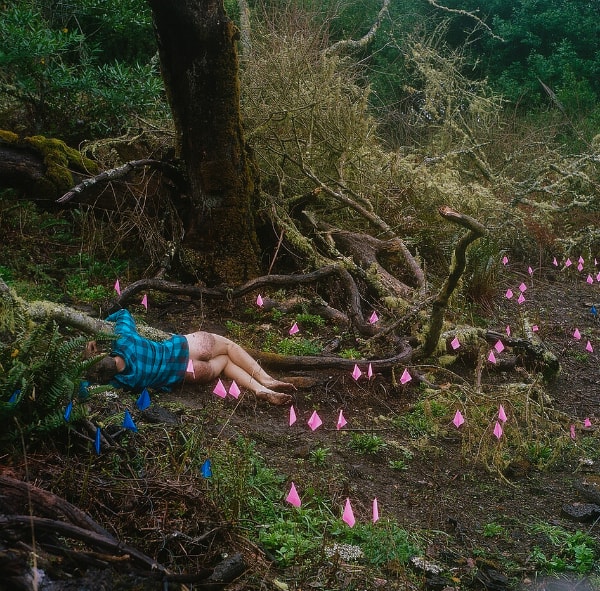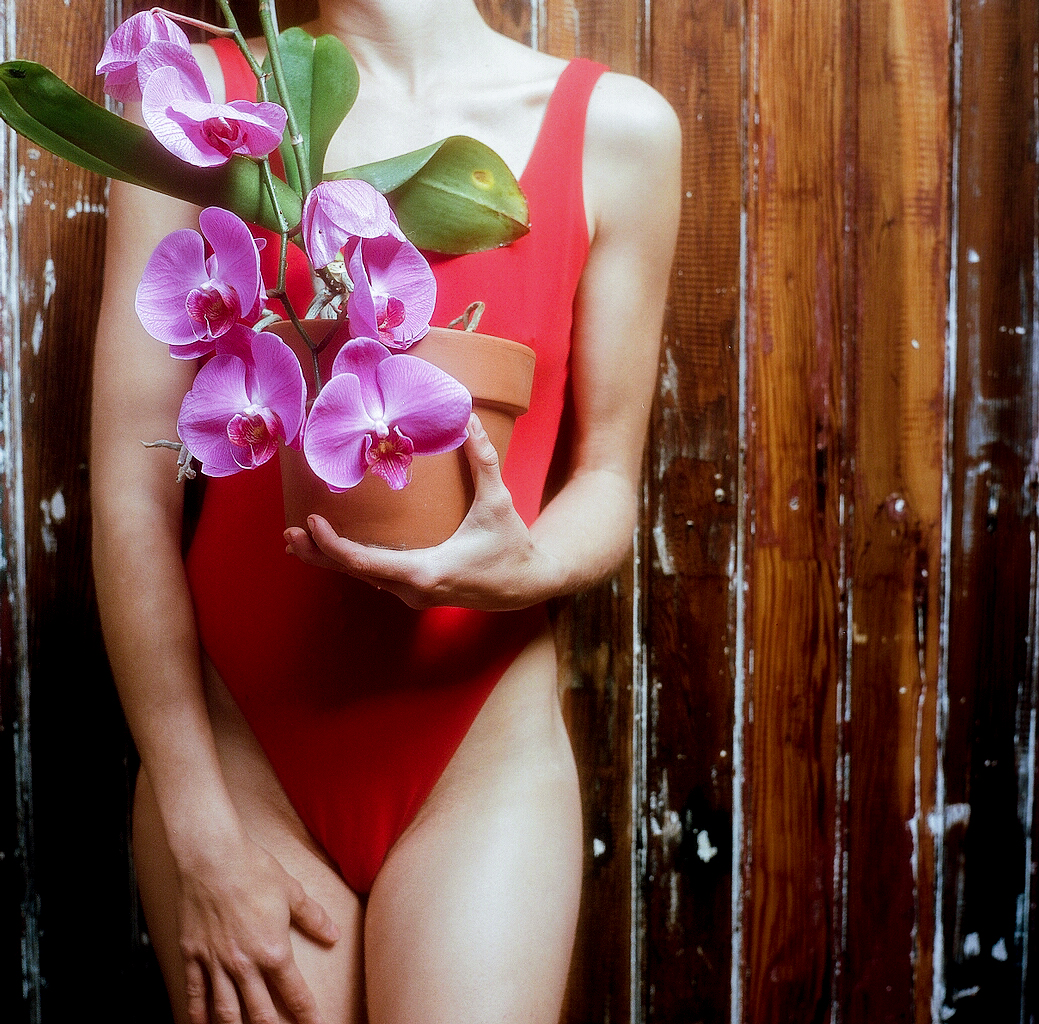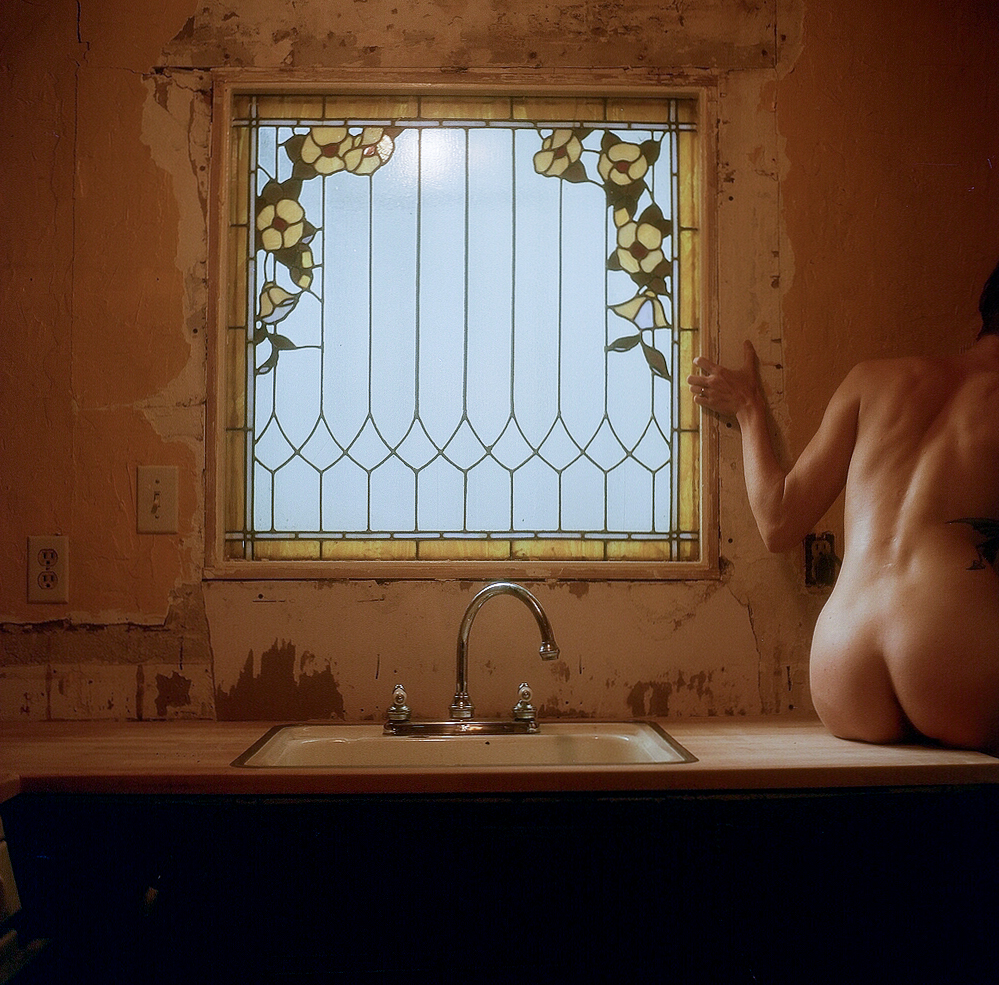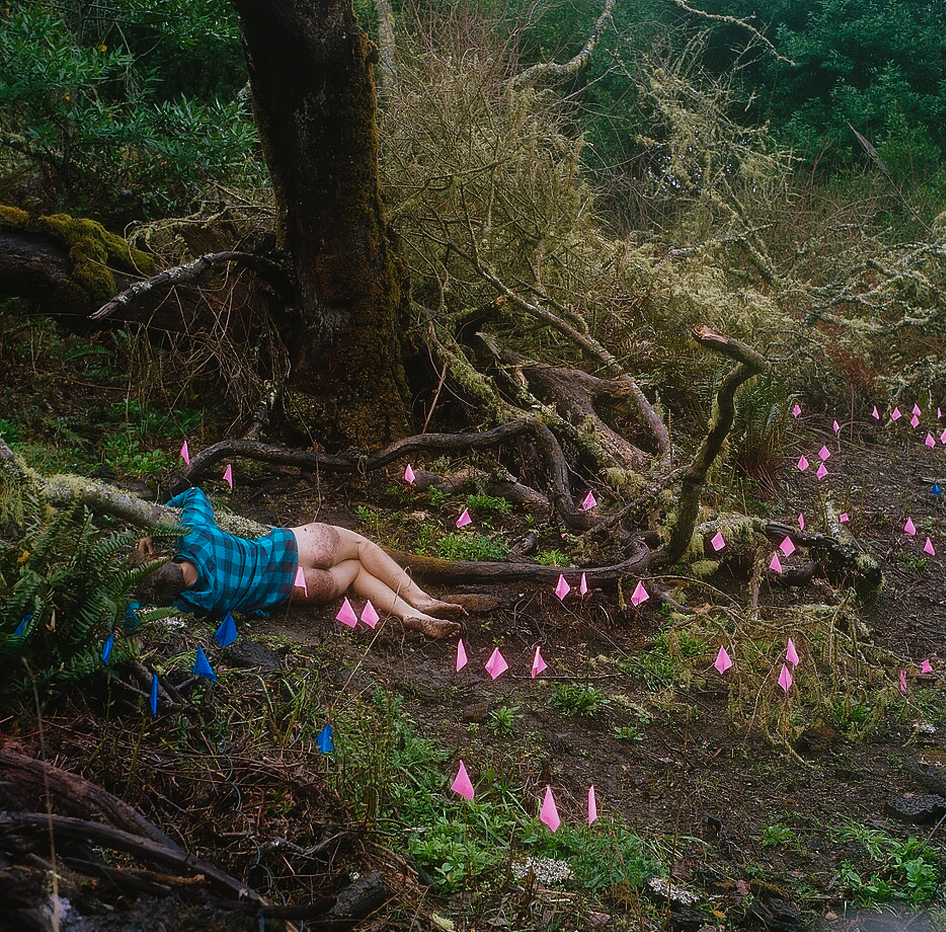
“If survivors retain control over the interpretation of their trauma, they can sometimes force a shift in the social and political structure,” writes Kali Tal in Worlds of Hurt, her landmark exploration of trauma and literature. The book—which focuses on the accounts of Holocaust survivors, Vietnam veterans, and victims of sexual violence—underscores the heroism of those who speak out about such experiences. When “‘telling it like it was’ threatens the status quo,” she warns, “powerful political, economic, and social forces will pressure survivors either to keep their silence or to revise their stories.”
Rowan Renee’s photographs refuse to be shrugged off or assimilated. “Bodies out of Wood,” their new show at Peninsula Art Space, explores the sexual abuse they suffered at the hands of their father, a convicted pedophile who died in prison five years ago. Renee, who uses gender-neutral pronouns, makes self-portraits depicting the complex scars of this trauma and the costs of staying silent. Renee does not coddle viewers or gloss over tragedy, but their self-portraits are also fundamentally hopeful. “I’m really lucky to have art,” they told me, the day before the show’s opening. “It’s a way I can meaningfully process. And potentially impact other people.”
Renee’s photographs are visceral yet multilayered. In one image, the artist waves a burning stick before their naked body. Tattoos and piercings are markings they consented to, and their arms are flexed, a sign of power. They wield the alighted wood—with its capacity to sear and scar—in defense of their body. But this display of strength is also proof of imminent danger: the artist holds a weapon because they need one. The photo depicts the cruelties of patriarchy.

Experts on abuse recovery have long understood the healing power of speaking out about traumatic experiences. In Trauma and Recovery, a seminal book on the subject, psychiatrist Judith Herman identifies “reconstructing the trauma story” as one of the three stages of recovery—after “establishing safety” and before “restoring connection” to the community. Too often, though, survivors’ efforts to express themselves are thwarted. Perpetrators may threaten victims to keep them quiet or, failing that, seek to discredit their accounts.
Meanwhile, on the cultural level, survivors’ stories are often incorporated in deference to existing power structures. Tal theorizes three modes of cultural coping in response to survivor testimony: “mytholization” flattens an experience to a familiar, non-threatening narrative; “medicalization” assumes victims have an “illness” that can be cured through institutionalized medicine; and “disappearance” denies the existence of certain experience. When these mechanisms succeed, patterns of violence perpetuate.
In their photographs, though, Renee takes a different tack: rather than spell out what happened, their images depict trauma’s ineffable aftershocks.
Renee begins and ends “Bodies of Wood: A Legacy of Sexual Abuse,” an essay accompanying their exhibit, with fantasies about speaking out. In an opening dream sequence, the artist tells their mother’s secrets to a “sea of faces” at her funeral. For Renee, this confession is cathartic; but for their mother, the disclosure means betrayal. Like so many victims, she sees silence as a survival skill, a way of navigating a world that denies her experiences. Similarly, at the end of the essay, Renee recalls their father’s funeral. They imagine “scream[ing] a smashing rage” at a moment when, outwardly, they stayed quiet. “If you were there you might have mistaken me for a good girl,” the piece concludes. They articulate on the page what is unspeakable in life.
In their photographs, though, Renee takes a different tack: rather than spell out what happened, their images depict trauma’s ineffable aftershocks. Just below each picture’s surface, instability abounds. In one image, the artist holds a pot of orchids, slightly askew. The flowers—with all their erotic connotations—are pink and voluptuous but not unequivocally beautiful. They clash with the artist’s red bathing suit. Renee’s body seems divided in response to the plant: one bicep is tense and straining; the other arm rests at their side.

Renee’s pictures also tend to infuse domestic scenes with a sense of terror. One photo shows the artist’s body perched precariously on the kitchen counter. This posture—as Renee’s wiry upper torso collides with a curvy lower half—makes it difficult to code their body as male or female. Around them, paint is peeling and the room’s stained-glass window is off-kilter. Every aspect of this seemingly ordinary scene feels slippery and unsustainable, as if built on a rotten frame.
Through their self-portraits, Renee not only externalizes their inner landscape but also remakes it into something new and emotionally useful. “I was working with what I had,” they said, pointing out a photo of them lying in the midst of a California forest, nestled between moss and debris. In the picture, the blue in their flannel shirt picks up the color of flags planted in the ground nearby. Soil stains their thighs. Their body is marked by the landscape, but the artist is also in control, transforming their surroundings from within.
Renee uses their past as artistic material to respond to and re-present. This power is laced with responsibilities: how does art represent violence without perpetuating it?
Similarly, Renee uses their past as artistic material to respond to and re-present. This power is laced with responsibilities: how does art represent violence without perpetuating it? Does art about trauma aim to traumatize its viewers? Is that okay? Part of the way Renee navigates these issues is by making the boundary between art and life visible within each frame. For instance, in one particularly wrenching photo, the artist stands beside a pile of wood, naked from the waist down, except for their black-and-red striped socks. Blood-like liquid in their hand also stains their shirt and thighs. These markings, including several handprints, are traces of violence visited on the body, but they are also clearly fake: evidence of the scene’s creation—water, dye, and a mixing bowl—is displayed at the artist’s feet.
The line between simulated and actual violence is among the issues at stake in Maggie Nelson’s The Art of Cruelty. In her lucid analysis of when violent art is “worthwhile” and when it isn’t, Nelson considers Paul McCarthy and Mike Kelley’s 1987 video Family Tyranny. The film involves a father figure forcing mayonnaise through a funnel into a foam ball, saying things like “My daddy did this to me; you can do his to your son, too.” Nelson writes that this obvious artifice—the food product for cum, a ball for a head—renders the incest scene’s “nearly unwatchable cruelty” more “bearable.” But Nelson also contends that simulation “makes the piece more insidious, as it liberates the abuse from the burden of believable representation, and places a crystallized version of its effects on display.” By decoupling the scars of trauma and the specificity of violent event, Kelley—and Renee, for that matter—makes the argument that sexual abuse is inherited and ideological. There is no getting away from it. In their essay, Renee puts it another way: “The cycle of abuse may just be another feature of human civilization, like breathing and fucking.”

Indeed, Renee’s photos invite us to consider our role in sustaining patterns of family-based violence, simply by looking the other way. In one picture, the artist is naked and curled up on the concrete of a parking lot. Tucked behind the white barrier, their body almost blends in with the surroundings but doesn’t. To pass by and not stop would be to move through our days in strategic ignorance. And yet, it is all too tempting: not-seeing makes the world an easier place to be.
In this sense, “Bodies of Wood” offers a critique of our economy of attention. The show asks us to face what we don’t (want to) know about the prevalence of sexual abuse in families and the trauma its victims live with. Mostly, though, Renee’s self-portraits are an expression of agency in self-representation. With each click, they displace the male gaze and define themself. The last word is theirs.

